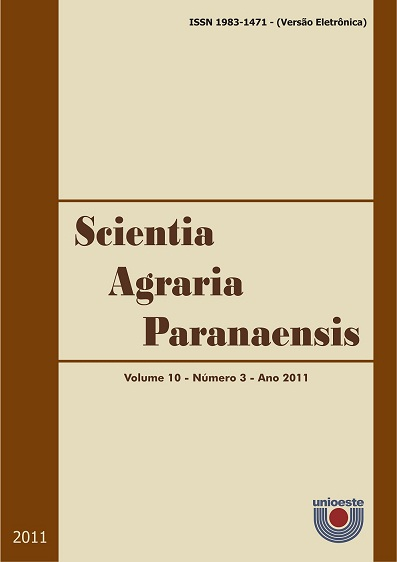Growth analysis of sorghum underdifferent stands
DOI:
https://doi.org/10.18188/sap.v10i3.4255Keywords:
Sorghum bicolor L., densidade, fotossíntese, crescimentoAbstract
In view of the current and increasing importance of the culture of sorghum in Brazil, and that the same one can be cultivated in not favorable of the soil and clima conditions to other cereals, the analysis of growth of plants of this species under different densities of plantation was carried through. The experiment was developed at the University Campus of Gurupi-TO, pertaining it the Federal University of Tocantins, in delineation of blocks at random with five repetitions. Four densities of culture, corresponding 140, 200, 260 and 320 thousand plants for hectare had been used. The evaluations, spaced of ten days between themselves, were effected during all the cycle of the plants. It was verified that the lesser densities of culture had presented greater taxes of absolute growth (TCA), tax of liquid assimilation (TAL) and reason of stem mass (RMC). The biggest densities of culture presented greater specific foliar area (AFE) and reason of foliar mass (RMF). Considering the occurrence of water deficiency in the end of the plants cycle, it was observed that the treatments under bigger densities of culture had been the ones that had less suffered with this stress.Downloads
Published
27-01-2012
How to Cite
TERRA, T. G. R.; LEAL, T. C. A. de B.; SIEBENEICHLER, S. C.; NETO, J. J. D.; DOS ANJOS, L. M.; CASTRO, D. V. de. Growth analysis of sorghum underdifferent stands. Scientia Agraria Paranaensis, [S. l.], v. 10, n. 3, p. p. 45–57, 2012. DOI: 10.18188/sap.v10i3.4255. Disponível em: https://e-revista.unioeste.br/index.php/scientiaagraria/article/view/4255. Acesso em: 25 jul. 2025.
Issue
Section
Scientific Article
License
Aviso de Direito Autoral Creative Commons
Política para Periódicos de Acesso Livre
Autores que publicam nesta revista concordam com os seguintes termos:
1. Autores mantém os direitos autorais e concedem à revista o direito de primeira publicação, com o trabalho simultaneamente licenciado sob a Licença Creative Commons Attribution que permite o compartilhamento do trabalho com reconhecimento da autoria e publicação inicial nesta revista.2. Autores têm autorização para assumir contratos adicionais separadamente, para distribuição não-exclusiva da versão do trabalho publicada nesta revista (ex.: publicar em repositório institucional ou como capítulo de livro), com reconhecimento de autoria e publicação inicial nesta revista.
3. Autores têm permissão e são estimulados a publicar e distribuir seu trabalho online (ex.: em repositórios institucionais ou na sua página pessoal) a qualquer ponto antes ou durante o processo editorial, já que isso pode gerar alterações produtivas, bem como aumentar o impacto e a citação do trabalho publicado (Veja O Efeito do Acesso Livre).
Licença Creative Commons
Esta obra está licenciada com uma Licença Creative Commons Atribuição-NãoComercial-CompartilhaIgual 4.0 Internacional, o que permite compartilhar, copiar, distribuir, exibir, reproduzir, a totalidade ou partes desde que não tenha objetivo comercial e sejam citados os autores e a fonte.


